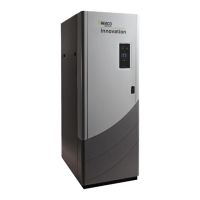relay energizes when any fault condition occurs and remains energized until the fault is cleared
and the CLEAR button is depressed. The Fault Relay connections are shown in Figure 2.12-2.
2.12.14 AUX RELAY Terminals
Each unit is equipped with a single pole double throw (SPDT) auxiliary relay that is energized
when there is a demand for heat and de-energized after the demand for heat is satisfied. The
relay is provided for the control of auxiliary equipment, such as pumps and louvers, or can be
used as a unit status indictor (firing or not firing). Its contacts are rated for 120 VAC @ 5 amps.
Refer to Figure 2.12-2 to locate the AUX RELAY terminals (N.C., COM, & N.O.) for wiring
connections.
2.13 FLUE GAS VENT INSTALLATION
The Innovation-Edge Venting and Combustion Air Design Guide (TAG-0090, GF-5056) must be
consulted before any flue or combustion air venting is designed or installed.
Suitable, U/L approved, positive pressure, watertight vent materials MUST be used for safety
and UL certification. Because the unit is capable of discharging low temperature exhaust
gases, the flue must be pitched back towards the unit a minimum of 1/4" per foot (21 mm per m)
to avoid any condensate pooling and to allow for proper drainage. In addition, you must add a
bead of high temperature red silicon sealant (such as Permatex Hi-Temp Red RTV or Loctite
Superflex Red High Temp RTV) between the exhaust manifold and the mating flange of the
exhaust connector, as shown in Figure 2.13.
Figure 2.13. Exhaust Vent Connection
While there is a positive flue pressure during operation, the combined pressure drop of vent and
combustion air systems must not exceed 140 equivalent feet (42.7m) or 0.81” W.C. (201 Pa)
with 6” (15.24 cm) piping. Fittings as well as pipe lengths must be calculated as part of the

